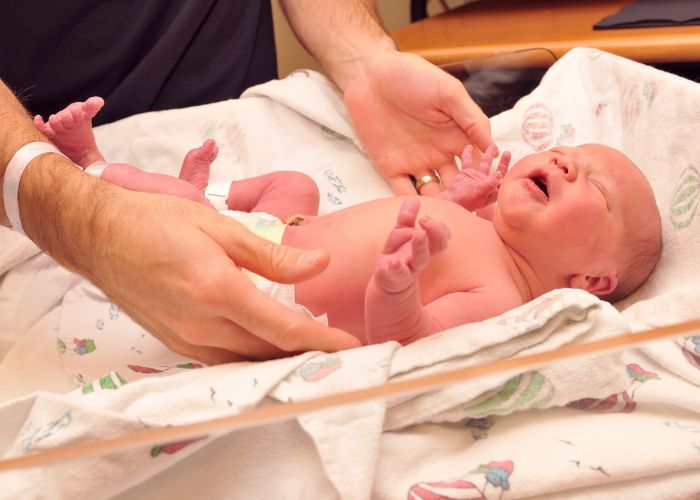In the first three months of the year, 78,535 babies were born in Spain, an average of only 873 per day, which is the second lowest figure since data have been available.
Only during the same period in 2021, in the middle of the pandemic, were the figures even slightly lower, according to the latest monthly birth statistics from the Spanish statistics office INE.
The data show that 2016 was the last year in which more than 100,000 babies were born in Spain during the first quarter of the year. And, 2017 was the last year in which the number of births per day exceeded 1,000.
In 2016, 100,432 children were born between January and March, an average of 1,104 per day. However, this fell to 94,894 and 1,054 in 2017, respectively. Then, the first quarter of 2020 saw only 86,420 births which averaged 950 per day.
Covid’s impact was significant. In the first quarter of 2021, only 77,243 children were born during the peak of the pandemic. Then they were averaging 858 per day, figures that rose very slightly in the same period of 2022 and then fell again in 2023.
Also read: Spanish government wants app to encourage men to do more housework
Half as many newborns as half a century ago
This year’s figures contrast sharply with those of the year when Spain recorded the most births in a first quarter. This was in 1974, when 164,069 babies were born. That´s 1,823 per day, more than twice as many as today.
In percentage terms, the trend in the number of daily births in the first quarter of this and the seven previous years is as follows:
- 2017, it fell by 4.46%
- 2018 it dropped to 5.26%
- 2019, the decline was reduced to 2.66%
- 2020, it levelled off to 2.34%
- 2021, under the impact of the pandemic, it plummeted by 9.63%
- 2022, it recovered by 3.43%
And, so far this year, the first quarter shows a decline of 1.70%.
Absolute figures
In absolute terms, the 78,535 births in the first three months of this year are 7,885 less than in 2020 and 21,897 less than in 2016. That is 77 births per day less than before the pandemic, (-8.11%), and 231 less than in 2016, -20.93%).
Aragón is the exception
The negative trend in the birth rate is occurring almost all over Spain. However, Aragón can report that, despite the drawbacks of the difficult health situation, the birth rate has at least maintained its level.
In the other regions, births have continued to fall to varying degrees, measured by the average number of births per day in the first quarter of this year compared to the same months in 2020. The largest declines are seen in the following areas;
- Navarre (-16.95%)
- La Rioja (-15.40%)
- The Basque Country (-14.48%)
- Castilla-La Mancha (-14.28%)
- The Canary Islands (-13.32%)
Declines below the national average are seen in the following areas;
- Madrid (-1.81%)
- The Valencian Community (-4.68%)
- Extremadura (-6.63%)
- Andalusia (-6.94%)
Of every 100 children currently born in Spain, around two-thirds are born in just four communities: 19 in Andalucia, 17 in Catalonia, 16 in Madrid and 11 in the Valencian Community. Of the latter third, four are born in Galicia, the Basque Country, Murcia, Castilla-La Mancha, Castilla y León and the Canary Islands; three in Aragon and the Balearic Islands; two in Extremadura and one in Asturias, Cantabria, Navarre and La Rioja.
Birth rate and depopulation, two related phenomena
The birth rate is directly related to depopulation. Jaume Font, geographer and professor at the University of Barcelona, points out in his book Las Españas despobladas that only provinces like Murcia, Almería and Huelva, which receive migrants for agricultural labour, show some growth. Immigration, Font reminds us, is mostly by young people, generally of childbearing age.
Also read: Spain top in parental leave equality
The provinces with the most marked population decline are Salamanca, Zamora, Ourense and Lugo. ‘And the region of Asturias,’ explains Font, who points out that the minimum fertility rate per woman during her childbearing life should be 2.1 children. ‘Almost no country in Europe meets that. But it is especially low in countries with a Catholic tradition such as Portugal, Spain, which stands at 1.19, or Italy, and higher in, say, France or Ireland, probably because of government support’.
In the peninsula, there are two main sparsely populated areas: on the one hand, the north-west, especially Ourense, Lugo, Zamora, rural León and Salamanca and inland Asturias, and on the other, the Iberian system and especially the Celtiberian Serranía, the Celtiberian mountains.
Also read: Lowest birth rate in 80 years in Spain


